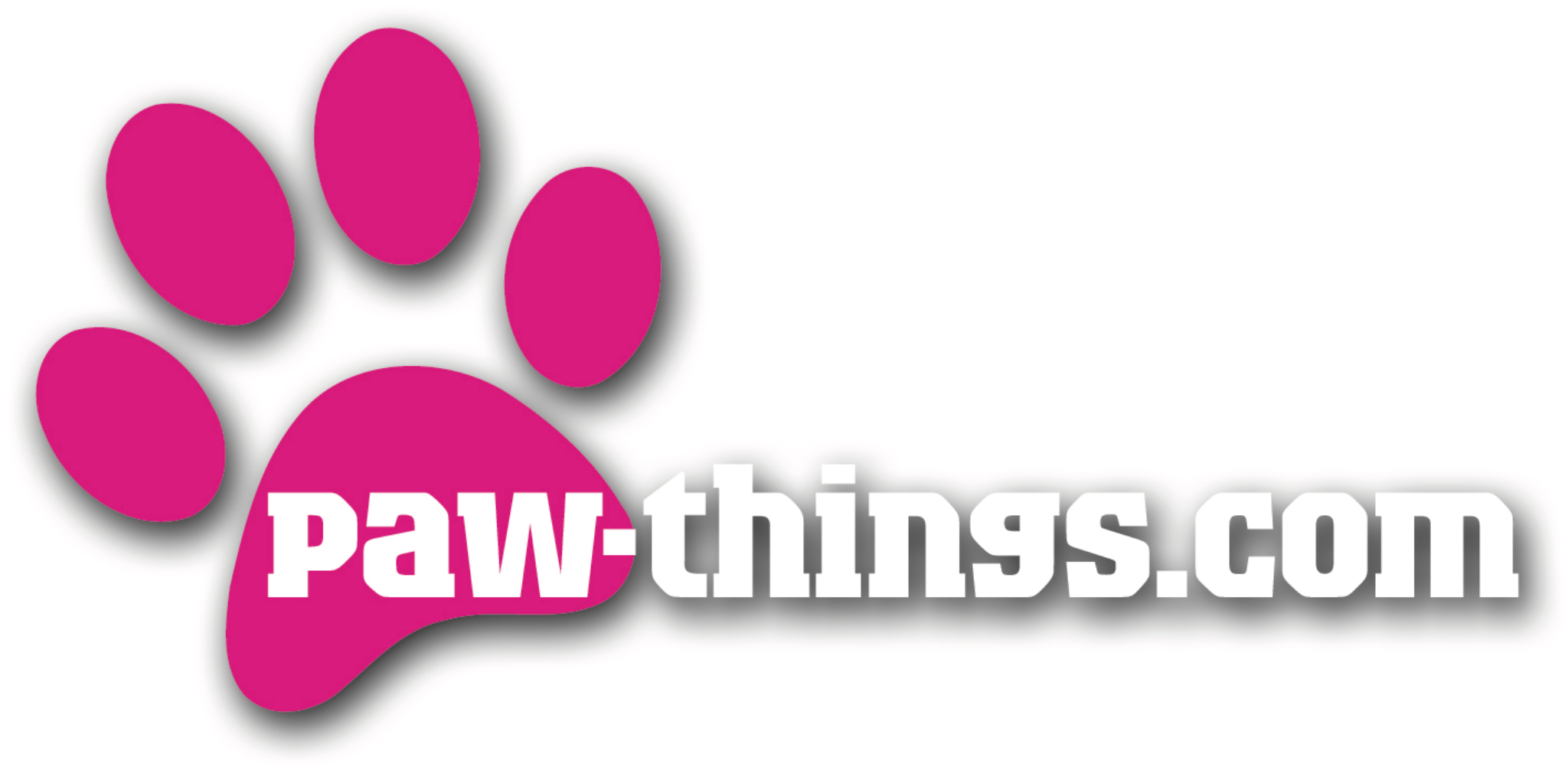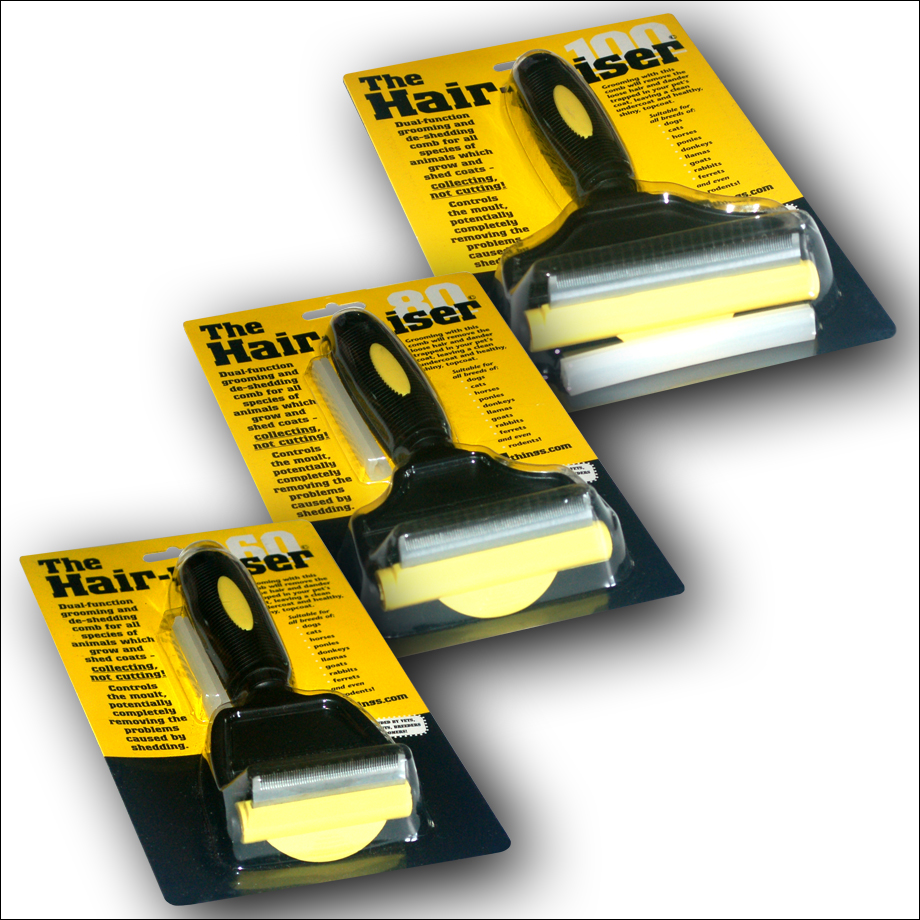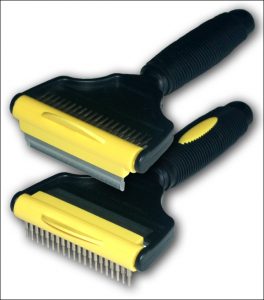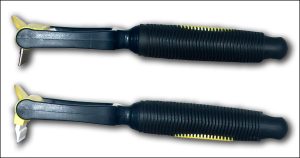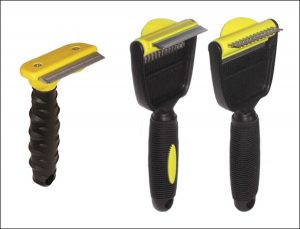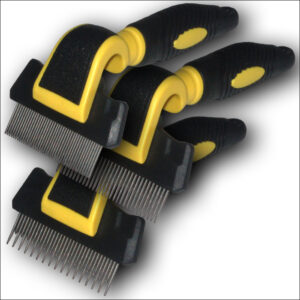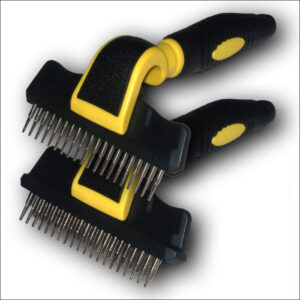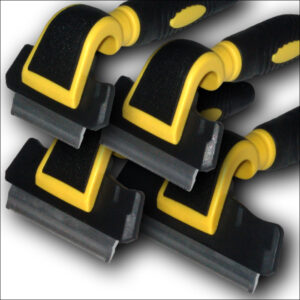Hair-raiser ‘Duo’ comb/rake range
£24.50 – £29.50
Description
Grooming with the Hair-raiser© Duo – which is available in a range of three sizes – removes the loose hair and dander trapped in your pet’s coat, leaving a clean undercoat and healthy, shiny, topcoat.
I first saw this comb demonstrated at a trade fair in China, early in 2009. The demonstration involved a spaniel with a coat which already looked in pretty good condition to me.
A few strokes of the Hair-raiser© using the widely-set rake followed by just a couple of strokes using the narrow-set teeth resulted in a comb-ful of dead hair and other grot! There was no cutting involved – all the hair must have been lying loose in the dog’s coat. And the dog was clearly enjoying the grooming experience!
This is a product which may revolutionise the way you care for your pet’s coat! We are pleased to be the sole importer of the Hair-raiser© into the UK – this product is only available directly from us.
Simply flip between the two combs!
With the wide-set rake teeth comb of the Hair-raiser© engaged, gently groom your pet’s coat to free any loose hair trapped in the coat; at the same time knotted or matted hair will be freed or even trapped and removed. Stroke as you would with a hair brush – up and away from the animal’s body. Depending on the breed of pet and condition of its coat, an amount of the freed hair will be completely removed by the rake teeth. However, most of the loose hair and dander – small particles of skin, similar to dandruff – will remain in the coat.
Some short-haired breeds will not require the use of the wide-set rake teeth. On the other hand, with profusely-shedding coats you may spend many weeks grooming and collecting with only the wide-set rake teeth before the coat is in a condition which permits collecting the dead hair with the narrow-set de-shedding comb teeth.
Flipping the head of the Hair-raiser© engages the narrow-set, stainless steel, precision engineered, de-shedding comb teeth. Re-grooming the previously-raked area collects and removes all the remaining loose hair and dander.
Removing trapped, loose hair immediately it has been freed avoids it transferring to furniture, carpets, car seats or clothing – so everyone and everything stays cleaner. (And we all know the smell of a neglected coat after the animal has been out in the rain!)
With increasing usage and familiarity you’ll discover the combination of the two combs which is appropriate for different areas of the coat.
To take the example of a spaniel, to maintain the leg feathers in optimum condition expect to make more use of the wide-set rake teeth, whilst on the legs themselves expect to make more use of the narrow- set de-shedding comb teeth.
Using the Hair-raiser© also benefits the animal’s coat, stimulating the growth of new, healthy hair. After just a few grooming sessions the general improvement in the appearance and condition of your pet’s coat will be noticeable.
How soon can you start using the Hair-raiser©? We started gently grooming (more like stroking with the comb, really!) our new labrador puppy at eight weeks. Not much hair gathered in the early days but by ten weeks we’d started collecting a measureable amount of discarded hair. Of course, every breed, and every dog within every breed, will be different.
To maintain your pet’s coat in optimum condition use the Hair-raiser© once or twice a week. Always groom gently and calmly, in the direction of the coat is laying, avoiding irritation of the skin.
Take care when grooming in particularly sensitive areas – for example the tummy and genitals. The experience should be pleasurable for both you and your pet!
When you pick up a Hair-raiser©, the first thing that will strike you is the quality of manufacture.
The unit as a whole has a solid ‘feel’ to it, the head pivoting between the two combs with a reassuringly firm, yet easy, motion.
The handle features a soft-grip rubber covering.
The Hair-raiser© is supplied complete with a safety head cover which can be fitted over the finely-set teeth when not in use.
The Hair-raiser© is attractively presented in informative, vacuum-formed packaging – a fabulous gift for any pet lover!
Hair-raiser 60
The Hair-raiser range is available in three widths – the 60, the 80 and the 100. Your choice of Hair-raiser will be determined by a number of factors, for example, the size of the animal, the area to be groomed, the density of the coat, the time you have available for grooming, the price you want to pay. The Hair-raiser 60 is the narrowest comb in the range and is typically the optimum choice for smaller animals (including rabbits, ferrets and rodents) up to and including cats.
The range of dog breeds of a suitable size for the Hair-raiser 60 would typically be those up to, and including, springer spaniels. Of course you could use the Hair-raiser 60 to groom dogs up to the size of labradors – but using a relatively narrow comb on a relatively large dog will of course take longer than grooming with the more appropriately-sized Hair-raiser 80. (If you’re using a Hair-raiser 60 to groom a dog the size of a German Shepherd then you should be seriously considering trading up to at least a Hair-raiser 80, or more probably a Hair-raiser 100; they cost a few pounds more but will speed up the job dramatically!)
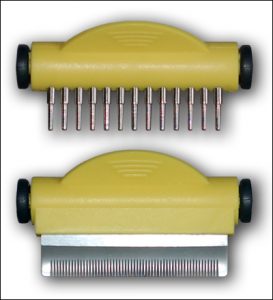 The two sets of Hair-raiser 60 teethIf you’re really undecided about which of two widths to choose, we’d suggest you choose the narrower width; although inevitably slower, it will be easier to use as you navigate around the nooks and crannies. If you later decide a wider comb would be more effective, by then you’ll have a queue of people who’ll have seen the results and will welcome your old comb!
The two sets of Hair-raiser 60 teethIf you’re really undecided about which of two widths to choose, we’d suggest you choose the narrower width; although inevitably slower, it will be easier to use as you navigate around the nooks and crannies. If you later decide a wider comb would be more effective, by then you’ll have a queue of people who’ll have seen the results and will welcome your old comb!
The 13 widely-set teeth of the Hair-raiser 60’s rake comb are individually – and robustly – set into the casement.
Almost 60 (yes, they’ve actually been counted!) finely-set teeth comprise the de-shedding comb, precision-engineered from a single piece of stainless steel and extending to the full 3 inches (7.5 cms) width of the head of the comb (in use, this seems to be just about the perfect grooming width for smaller animals). The close set of the teeth ensure that there is no collection wastage when the dead hair is combed out.
As the comb head is flipped between combs, the chosen set of teeth lock firmly into place.
 The Hair-raiser© 60 measures 3 x 7.5 inches (7.5 x 19.5 cms) and, weighing 5 ounces (150g), feels reassuringly substantial in the hand.
The Hair-raiser© 60 measures 3 x 7.5 inches (7.5 x 19.5 cms) and, weighing 5 ounces (150g), feels reassuringly substantial in the hand.
The packaging of each Hair-raiser© 60 contains detailed information on ways to maximise its usefulness on your animal.
Hair-raiser 80
The Hair-raiser range is available in three widths – the 60, the 80 and the 100. Your choice of Hair-raiser will be determined by a number of factors, for example, the size of the animal, the area to be groomed, the density of the coat, the time you have available for grooming, the price you want to pay. The Hair-raiser 80 is the middle comb in the range and is typically too large for animals smaller than large dogs.
The range of dog breeds of a suitable size for the Hair-raiser 80 would be those from springer spaniels to golden retrievers. Of course you could use the Hair-raiser 80 to groom even larger dogs – but the more appropriately-sized Hair-raiser 100 would get the job done more quickly!
The two sets of Hair-raiser 80 teethIf you’re really undecided about which of two widths to choose, we’d suggest you choose the narrower width; although inevitably slower, it will be easier to use as you navigate around the nooks and crannies. If you later decide a wider comb would be more effective, by then you’ll have a queue of people who’ll have seen the results and will welcome your old comb!
The 20 widely-set teeth of the Hair-raiser 80’s rake comb are individually – and robustly – set into the casement.
Almost 80 (yes, they’ve actually been counted!) finely-set teeth comprise the de-shedding comb, precision-engineered from a single piece of stainless steel and extending to the full 4 inches (10 cms) width of the head of the comb (in use, this seems to be just about the perfect grooming width for largish dogs). The close set of the teeth ensure that there is no collection wastage when the dead hair is combed out.
As the comb head is flipped between combs, the chosen set of teeth lock firmly into place.
 The Hair-raiser© 80 measures 4 x 7.5 inches (10.0 x 19.5 cms) and, weighing 6.5 ounces (200g), feels reassuringly substantial in the hand.
The Hair-raiser© 80 measures 4 x 7.5 inches (10.0 x 19.5 cms) and, weighing 6.5 ounces (200g), feels reassuringly substantial in the hand.
The packaging of each Hair-raiser© 80 contains detailed information on ways to maximise its usefulness on your animal.
Hair-raiser 100
The Hair-raiser range is available in three widths – the 60, the 80 and the 100. Your choice of Hair-raiser will be determined by a number of factors, for example, the size of the animal, the area to be groomed, the density of the coat, the time you have available for grooming, the price you want to pay. The Hair-raiser 100 is the widest of the three combs in the range and is typically too large for animals smaller than very large dogs.
The range of dog breeds of a suitable size for the Hair-raiser 100 would be those at least equal to the size, and coat density, of golden retrievers. Of course you could use the Hair-raiser 80, or even the Hair-raiser 60, to groom such large or heavily-coated dogs – but the more appropriately-sized Hair-raiser 100 would get the job done more quickly!
Of course, the Hair-raiser 100 can be used on a lot more species of animals than dogs. Alpacas, goats, llamas, donkeys, horses, cattle… if it grows a coat the Hair-rasier can groom it!
The two sets of Hair-raiser 100 teethIf you’re really undecided about which of two widths to choose, we’d suggest you choose the narrower width; although inevitably slower, it will be easier to use as you navigate around the nooks and crannies. If you later decide a wider comb would be more effective, by then you’ll have a queue of people who’ll have seen the results and will welcome your old comb!
The 26 widely-set teeth of the Hair-raiser 100’s rake comb are individually – and robustly – set into the casement.
Almost 100 (yes, we’ve actually counted them!) finely-set teeth comprise the de-shedding comb, precision-engineered from a single piece of stainless steel and extending to the full 4 inches (10 cms) width of the head of the comb (in use, this seems to be just about the perfect grooming width for larger dogs and all equine animals). The close set of the teeth ensure that there is no collection wastage when the dead hair is combed out.
As the comb head is flipped between combs, the chosen set of teeth lock firmly into place.
 The Hair-raiser© 100 measures 5.0 x 7.5 inches (12.5 x 19.0 cms) and, weighing 7.5 ounces (225g), feels reassuringly substantial in the hand.
The Hair-raiser© 100 measures 5.0 x 7.5 inches (12.5 x 19.0 cms) and, weighing 7.5 ounces (225g), feels reassuringly substantial in the hand.
The packaging of each Hair-raiser© 100 contains detailed information on ways to maximise its usefulness on your animal.
Why groom?
 So what is lurking in a dog’s coat?…
So what is lurking in a dog’s coat?…
Fleas
By far the most common flea in both dogs and cats is the cat flea (Ctenocephalides felis).
Most dogs will suffer from a flea infestation at some point in their lives. It used to be that they were most at risk during the warmer months, the number of fleas normally decreasing during the cold winter months. However, as most houses are now centrally heated, the fleas are provided with an ideal environment in which to survive and breed all year around. For this reason, treatment against fleas should be provided throughout the year.
The length of the flea life-cycle depends on temperature and humidity. In an ideal environment (for the flea, not so ideal for the dog or cat!) the cycle can be around 21 days.
Some dogs will develop a hypersensitivity to flea saliva and this can lead to an itchy reaction. One or two fleas would be quite enough to cause a marked irritation. Most flea reactions in dogs are seen on the lower back area, above the tail.
Fleas spend the majority of their life-cycle in the home environment. Only adult fleas are seen on the dog. The female flea lays the eggs on the dog’s coat, these fall off and can be found wherever your dog spends most of his time – in his bedding, in the carpet, on the sofa – even on your bed!
The flea gains the nutrients to live by ingesting blood from your dog several times a day.
Adult fleas do not live for long on your dog and die after 7-14 days – only to be replaced by the ones developing in the environment.
Before the owner knows the dog has fleas, the owner will notice small specks of what appear to be grit on the dog’s coat. This may be flea faeces! To establish whether this is flea faeces, brush the coat and allow the material to fall onto a moist white tissue. Flea faeces will produce a red mark.
Besides picking the fleas up from around the house, dogs can also pick up fleas from outside the home or from other animals.
Fleas are also the intermediate host of the tapeworm. Therefore it is important to remember when treating your dog for fleas to treat for tapeworms too.
Effective flea treatment and control involves treating both the environment and the dog (for all the reasons stated above).
Flea preparations come in all forms – aerosols, powders, pump action sprays, insecticidal collars, spot-ons, oral tablets or shampoos. There are a large number of flea products available. Ask your vet for advice on which products will suit you and your dog’s needs.
Treatment of the environment involves using a recommended aerosol spray and regular vacuuming – don’t forget under the skirting boards, under the sofa cushions and the dog’s bedding.
Ticks
Ticks are usually picked up by your dog in long grass or in woodland. They often attach to the dog’s head and look like warts. They grow in size as they feed on your dog’s blood, and although if left alone will eventually fall off when full, prompt removal is necessary as they can pass on disease to your dog as they feed on your dog.
If you do not know how to remove ticks safely (just pulling them off may leave parts of the head still attached and cause a nasty infection) then ask your vet to show you.
Certain ‘spot-on’ preparations that you can use for flea prevention will also kill ticks, so ask your vet for advice on this too.
So what’s hiding in that matted hair?…
Very often you find dogs in dog shelters with matted hair. Usually, if it is a good shelter, these dogs would be new arrivals, if not the shelter is probably short on manpower.
You’ll find dogs with matted hair in homes as well. (Unfortunately not all dog owners are conscientious about their pets.)
Dogs with such problems are usually the breeds, or cross-breeds, with long-haired coats – particularly those breeds that have two coats (an ‘under-coat’ and a ‘top-coat’). Sometimes, you’ll find dogs with short-haired coats also have similar problems.
The problem needs to be taken care of. While this condition is harmful to the dog, it is also unhealthy for the humans and other dogs who live in the vicinity.
How is it harmful to the dog? Matted hair is a great hiding place for fleas, mites and ticks. Dander and dandruff (yes, even dogs are affected by dandruff) has a chance to thrive in the matted coat. Last of all – but perhaps most obviously! – the odour accompanying matted coat can be unbearable.
You don’t have to be a rocket scientist to work out that a dog with a matted coat is not comfortable and certainly not happy. How do you deal with such a problem? Read on…
First things first. Assess the extent of matting. Is it all over the coat? Is it dirt streaked? Is it only at the ends of the hair? Has the matting extended to the roots?
If the matting is all over the coat, dirt streaked and has extended to the roots, the best way to get rid of the problem is to cut away all of the dog’s coat. You have to take care while sniping away the hair that you don’t hurt the dog’s skin. The dog may look odd with its hair shorn off, but it really is far better off without the matted hair.
Having done that it’s time to groom the dog, treat it for ticks, mites, fleas and dandruff (more often than not such dogs will have all these infestations). Take care that the dog is regularly groomed, so that the condition does not recur.
If the matting is restricted to the ends of the hair, measures are not as drastic as suggested above. However, it is going to be a tedious job. Get the dog to lie on a table. (Keep some tidbits to tempt the dog to stay there. Of course if you have a way with dogs, you don’t need the tidbits.)
You’ll need a pair of small scissors as well as a good-sized one. The small scissors are for difficult places like the paws, the ears and eyes. Carefully snip off the matted parts.
After you have done the delicate areas, use the other larger scissors to snip off the rest of the matted hair.
Next, thoroughly comb the dog’s coat to remove small tangles. Once again check the dog for infestations and treat those conditions as well.
What happens with dogs which have short hair but a badly matted coat? More often than not the matting is due to dirt. So, very simply bathe the dog, groom it and you are rid of the problem. Once again check for infestations and treat the dog for them.
There is only one way you can avoid this problem from recurring – regular grooming.
Proper grooming for your dog does not only have aesthetic purposes but also adds to your pet’s holistic growth – physical and psychological. Since dog hair can interlace due to dirt and grime in the coat forming mats and tangles, they would need to be groomed to keep proper hygiene. And of course grooming generates more bonding time with your pet, creating a stronger relationship which your pet (and hopefully you!) will appreciate.
It is best to train your dog to be groomed from an early age. But an untrained dog can still be taught to accept the attention. Train your pet to get used to his body parts being handled and combed. With the Hair-raiser to hand you don’t need to go to a professional groomer, but if you don’t have the time or the interest to groom your dog, be sure to select a groomer that handles the animals gently.
Things to remember in grooming your dog
Make a daily examination of your pet’s body parts. Look out for bumps, hot spots, inflammation, irritation, vegetative matter, and parasites like fleas and ticks in his coat.
Get rid of fleas by using a fine-toothed comb (the fine-toothed comb on the Hair-raiser is perfect!); ticks can be tweezered off.
Ears should be checked – droop ears are inclined to infection which can lead to permanent hearing loss.
Examine your dog’s pads – dirt, grime, pebbles, chemicals can get caught and then infect the paws.
Combing not only removes matted hair, it also takes away dead hair, thus eliminating animal odour. Tangles can also be very painful for your dog that may lead to skin inflammation. Grooming during shedding encourages the growth of new coat, so comb especially after physical exercise.
Nails should be trimmed every month, especially if your dog finds walking at all difficult.
Dental hygiene is maintained by using dog toothpaste and toothbrush with soft bristles twice a week.
A damp cotton cloth is used to remove mucus from your dog’s eyes and a coarse rag is appropriate in cleaning your pet’s face.
When bathing your pet, make sure that you firstly comb away dead hairs to clear all the mats in his coat. Soak your pet in warm water. Apply a pet shampoo in small amounts. Target areas are the eyes, ears, rectum, toes and under the chin. Avoid getting soapy water in his eyes and ears. You also have an option to apply coat conditioner after bathing.
Different breeds require varying bath frequency; consult the local pet grooming shop or your vet if you’re not sure how many times you should bathe your dog.
It is recommended that a dog owner has her/his own home-grooming kit. A good kit includes a grooming brush, clippers for dog toenails, dog shampoo, coat conditioner, a coarse rag – and a Hair-raiser dual-purpose comb!
But you knew all that already, didn’t you!
